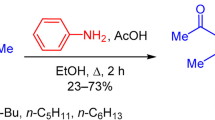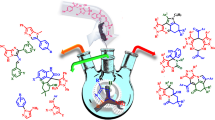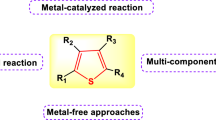Abstract
By cycloaddition reaction of sodium azide with chalcone in the presence of CuO as a catalyst in DMF a 1,2,3-triazole are prepared in reaction with pentafluoropyridine to give 2-(tetrafluoropyridin-4-yl)-1,2,3-triazole derivatives in good yields and high regioselectivity. The regioselectivity of the compounds are confirmed by 19F-NMR and other spectroscopy.
Graphical Abstract

Similar content being viewed by others
Background
Recently, perfluorocarbons have been used as building blocks in the pharmaceutical industry and in material science due to their unique properties (Kenneth 2006; Bruce 2001). In pharmacology and medicinal researches, it is common to substitute hydrogen with fluorine atom for increasing the physiochemical (e.g. solubility, stability) and biological activity (e.g. absorption, distribution, metabolism, elimination and toxicity) of drugs (Iwao 2009).
Pentafluoropyridine in which all the hydrogen atoms in pyridine ring have been replaced by fluorine atoms are highly susceptible towards nucleophilic attack owing to the presence of several highly electronegative fluorine atoms and nitrogen hetero atom; consequently, the chemistry of pentafluoropyridine is dominated by nucleophilic aromatic substitution processes and new chemistry continues to emerge (Iwao 2009; Reza et al. 2008; Mark et al. 2013; Van Ba and Donald 2012). The order of nucleophilic attack for pentafluoropyridine is established to be para > ortho > meta positions, so the reactions of pentafluoropyridine with some nucleophile occur selectively at the para position as this site is most activated towards nucleophilic additions to afford of 4-substited tetrafluoropyridine (Hadjar et al. 2001; Matthew et al. 2010; Jingjing et al. 2014).
Baohua Chen and coworker’s reported the synthesis of N-2-aryl-substituted-1,2,3-triazoles and arylation in the last step (Yuanqing et al. 2012). With this goal, we have employed the highly electron-deficient pentafluoropyridine for arylation of 1,2,3-triazoles in the last step for preparation of 2-tetrafluoropyridyl-1,2,3 triazoles (Fig. 1).
Earlier, we reported the synthesis of 4-substituted-2,3,5,6-tetrafluoropyridine derivatives by the reaction of pentafluoropyridine with malononitrile, 1-tetrazole-5-thiol, piperazine (Khalil et al. 2015), hydroxylated naphtoquinones and hydroxylated antraquinones (Khalil et al. 2016).
Results and discussion
In this research, we describe the synthesis of 2-tetrafluoropyridyl-4,5-disubstituted-1,2,3-triazoles via Diels–Alder cycloaddition reaction of sodium azide and 1,3-diphenylprop-2-en-1-one (chalcone) and then nucleophilic substitution reactions with pentafluoropyridine in DMF as solvent.
Reaction of 3-(phenyl)-1-phenylprop-2-en-1-one (chalcone) (1a) with sodium azide and one equiv catalyst of CuO in the solvent of DMF gave intermediate of 4-benzoyl-5-phenyl-1,2,3-triazol-2-ide 3 (TLC monitoring during the course of the reaction; Fig. 2). In last step, nitrogen nucleophile of 1,2,3-triazoles (intermediate 3) attack at the most activated 4-position of pentafluoropyridine and elimination of 4-fluor pyridine ring leads to the formation of (2-(perfluoropyridin-4-yl)-5-phenyl-2H-1,2,3-triazol-4-yl)(phenyl)methanone 2a in good yield. In the mechanism of this transformation CuO acted as the oxidant and then Cu was oxidized to CuO by air. In this search, we did not perform any optimization for this protocol and utilize the same condition reported in previous paper (Yuanqing et al. 2012).
Purification of 2a was achieved by column chromatography using ethyl acetate/n-hexane (2:10). The melting point, 19F, 1H, 13C NMR and mass spectra of the obtained product clearly indicated the formation of (2-(perfluoropyridin-4-yl)-5-phenyl-2H-1,2,3-triazol-4-yl)(phenyl)methanone 2a. For example, in the 1H NMR spectrum of compound 2a, the aromatic proton resonances were observed as multiplets at δ = 7.60–8.61 ppm. The 13C NMR spectrum of compound 2a showed 20 distinct resonances consistent with the recommended structure.
In 19F NMR analyze of 2a exhibited two peaks for fluorine’s, a peak is observed at down field of doublet of doublet at δ = −89.54 (J = 24, 28 Hz) for F-2,6 (ortho positions) and also, a doublet of doublet is remarked at up field −144.83 (J = 20, 8 Hz) for F-3,5 (meta positions). A part of the 19F NMR spectrum of 2a is shown in Fig. 3. 19F NMR analysis of 2a confirmed that the nucleophilic substitution had occurred at the 4-position of pyridine ring. The mass spectrum of 2a displayed molecular ion peak (M+) at m/z = 399, which is consistent with the proposed structure. Other ion peak are shown in mass spectra of 2a (Fig. 4).
The structure of compounds 2b was confirmed by NMR spectroscopic data. In particular, 19F-NMR spectroscopy show the chemical shift of fluorine atoms attached to the ortho and meta position are observed respectively at −95 and −153 ppm. The 1H NMR spectra of compound 2b showed an H broad signal at 4.5 ppm for OCH3 group, and the protons of the phenyl ring were observed at δ = 7.6–8.6 ppm. The mass spectrum of 2b displayed the molecular ion peak (M − 1) at m/z = 427, which is consistent with the proposed structure.
Experimental
All reagents and solvents were purchased from Aldrich and Merck were used without further purification. The 1H and 13C NMR spectra were obtained on Bruker with DMSO as a solvent (1H NMR at 300 MHz and 13C NMR at 75 MHz). In the 19F-NMR spectra (282 MHz), up field shifts were quoted as negative and referenced to CFCl3. Mass spectra were taken by a Micro mass Platform II: EI mode (70 eV).
General procedure for the preparation of 2-(tetrafluoropyridin-4-yl)-1,2,3-triazole
A mixture of chalcone (1 mmol), sodium azide (1 mmol) and CuO (2.5 mol%) were stirred in DMF (3 mL) for 20 h at 100 °C. After completion of the reaction as indicated by TLC pentafluoropyridine (1 mmol) was added to the mixture and the reaction continued at 100 °C for 5 h. Following, to the reaction mixture was added water 4 mL, and extracted with ethyl acetate and dichloromethane (3 × 5 mL). The solvent was removed in vacuo, and the crude product was purified by column chromatography using ethyl acetate/n-hexane (2/10) to give the pure product.
(2-(Perfluoropyridin-4-yl)-5-phenyl-2H-1,2,3-triazol-4-yl)(phenyl)methanone (2a)
(0.24 g, 65 %) as brown solid; mp 240–245 °C decompose. 1H NMR (DMSO): δ (ppm) 7.96–8.41 (10H, m, Ar–H); 19F NMR (DMSO): δ (ppm) −89.5 (2F, m, JFF 23, F-2,6), −144.8 (2F, m, JFF 20, F-3,5); 13C NMR (DMSO): δ (ppm) 126.81, 126.96, 127.40, 128.14, 128.18, 128.24, 128.29, 128.66, 128.74, 128.86, 128.92, 129.23, 129.44, 129.52, 129.77, 129.86, 170.31 ppm. MS (EI), m/z (%) = 415 [M+NH3]+, 399 (M), 384, 360, 343, 316, 286, 268, 248, 220, 199, 169, 141, 119, 101, 86, 58, 42.
(5-(4-Methoxyphenyl)-2-(perfluoropyridin-4-yl)-2H-1,2,3-triazol-4-yl)(phenyl)methanone (2b)
(0.20 g, 60 %) as a yellow solid; mp 265–270 °C decompose. 1H NMR (DMSO): δ (ppm) 4.5 (3H, OCH3) 7.60–8.61 (10H, m, Ar–H); 19F NMR (DMSO): δ (ppm) −95.0 (2F, m, F-2,6), −153.0 (2F, m, F-3,5); 13C NMR (DMSO): δ (ppm) 114.29, 115.54, 121.54, 122.94, 123.23, 127.82, 130.35, 130.85, 140.85, 141.22, 157.44 ppm. MS (EI), m/z (%) = 427 [M−1], 321, 282, 165, 91.
Conclusion
Diels–Alder cycloaddition reaction of chalcone with azide in the presence of CuO as catalyst gives 4,5-disubstituted 1,2,3-triazoles, in reaction with pentafluoropyridine give 4,5-disubstituted-2 tetrafluoropyridyl-1,2,3-triazoles.
References
Van Ba N, Donald JB (2012) Preparation of p-substituted tetrafluoropyridyl derivatives via the tetrafluoropyridylcopper reagent. J Fluor Chem 135:144–154
Bruce ES (2001) Fluorine substituent effects (on bioactivity). J Fluor Chem 109:3–11
Hadjar B, Richard DC, Philip RH, Graham S (2001) Multi-substituted heterocycles. J Fluor Chem 112:133–137
Iwao O (2009) Fluorine in medicinal chemistry and chemical biology. Blackwell, Oxford
Jingjing Wu, Dan F, Song C (2014) Synthesis of polyfluoroaryl-containing 1,2,3-triazoles by reaction of polyfluoroarenes, sodium azide and active methylene ketones/esters. J Fluor Chem 168(2014):230–235
Kenneth LK (2006) Fluorine in medicinal chemistry: recent therapeutic applications of fluorinated small molecules. J Fluor Chem 127:1013–1029
Khalil B, Reza H, Malek Taher M (2015) Synthesis of 2,3,5,6-tetrafluoro-pyridine derivatives from reaction of pentafluoropyridine with malononitrile, piperazine and tetrazole-5-thiol. SpringerPlus 4:757
Khalil B, Reza H, Malek Taher M (2016) Reaction of hydroxylated naphtoquinones/antraquinones with pentafluoropyridine. SpringerPlus 5:110
Mark AF, Graham P, Graham S, Andrei SB (2013) 19F and 13C GIAO-NMR chemical shifts for the identification of perfluoro-quinoline and-isoquinoline derivatives. J Fluor Chem 155:62–71
Matthew WC, Emma LP, Graham P, Rachel S, Graham S, Ian W, Dmitrii SY, Judith AKH, John AC, David DM (2010) Annelation of perfluorinated heteroaromatic systems by 1,3-dicarbonyl derivatives. Tetrahedron 66(2010):3222–3227
Reza RK, Graham S, Dmitrii SY, Judith AKH (2008) Macrocycles from pentafluoropyridine and tetrafluoropyrimidine. J Fluor Chem 129:307–313
Yuanqing Z, Xiaolong L, Jihui L, Jinying C, Xu M, Mingming Z, Baohua C (2012) CuO-promoted construction of N-2-aryl-substituted-1,2,3-triazoles via azide-chalcone oxidative cycloaddition and post-triazole arylation. Org Lett 14(1):26–29
Authors’ contributions
Acquisition of data: from articles and books: Analysis and interpretation of data: by RH and KB. Drafting of manuscript: KB. Critical revision: MTM. All authors read and approved the final manuscript.
Acknowledgements
The authors gratefully acknowledge partial support of this work by the Research Affairs Office of Sistan and Balouchestan University.
Competing interests
The authors declare that they have no competing interests.
Author information
Authors and Affiliations
Corresponding author
Rights and permissions
Open Access This article is distributed under the terms of the Creative Commons Attribution 4.0 International License (http://creativecommons.org/licenses/by/4.0/), which permits unrestricted use, distribution, and reproduction in any medium, provided you give appropriate credit to the original author(s) and the source, provide a link to the Creative Commons license, and indicate if changes were made.
About this article
Cite this article
Beyki, K., Maghsoodlou, M.T. & Heydari, R. Synthesis of 2-tetrafluoropyridyl-4,5-disubstituted 1,2,3-triazoles. SpringerPlus 5, 1961 (2016). https://doi.org/10.1186/s40064-016-3398-4
Received:
Accepted:
Published:
DOI: https://doi.org/10.1186/s40064-016-3398-4








